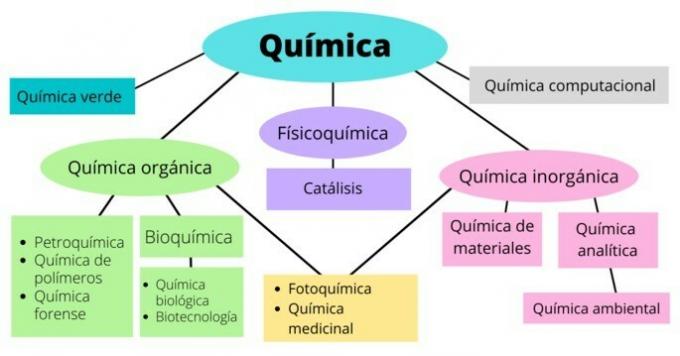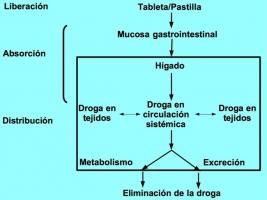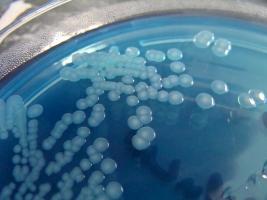17 branches of chemistry and what they study
Chemistry is the science that deals with everything related to matter, that is, everything that has mass and occupies space. Chemistry studies the composition, properties and changes that matter undergoes, such as For example, what happens when sodium reacts with water, or what happens when iron remains at outdoor.
This means that chemistry in general encompasses a huge field of study, from the atomic level to the biosphere and beyond, such as the composition of stars and planets. To facilitate the understanding of the various areas of action of chemistry there are various branches, being the first division of chemistry that occurred in the nineteenth century between organic chemistry and chemistry inorganic. Below are various branches of chemistry and their applications.

1. Organic chemistry
Organic chemistry is the branch of chemistry in charge of the study of carbon and its compounds, better known as organic compounds. Initially organic compounds were considered those compounds produced by living organisms. However, chemists today can synthesize many of these compounds in the laboratory.
Industries such as polymer industry, petrochemical industry, and pharmaceutical industry depend on organic chemicals.
2. Inorganic chemistry
This branch of chemistry is responsible for studying the inorganic compounds such as salts and minerals. These compounds are found in nature and cannot be synthesized by living things.
The main applications of inorganic chemistry are in metallurgy, nanotechnology and electronics, among others.
It may also interest you organic chemistry and inorganic chemistry.
3. Analytic chemistry
It is the branch of chemistry in charge of substance analysis. The main tasks of chemists in this field are to detect the presence of substances in mixtures (qualitative analysis) or to measure how much of a substance is in a mixture (analysis quantitative).
Analytical chemistry has applications in quality control and product development in industry.
4. Biochemistry
Biochemistry is the branch of chemistry that studies the structure and function of biological moleculessuch as proteins, nucleic acids, carbohydrates, and lipids. In biochemistry chemistry and biology are related.
Biochemists study the chemical reactions that occur in living organisms, such as digestion, metabolism, reproduction, and respiration.
5. Biotechnology
It is the application of biochemistry and biology to create and modify genetic material or organisms with a specific purpose.
Biotechnology is used in the creation of disease resistant crops, for the production of biofuels and for the production of inputs and supplements, among many other applications.
6. Photochemistry
It is the branch that studies the interaction of light with molecules, supramolecular systems and biological matter. Among these, the phenomena of luminescence, photosynthesis, phototherapy and the effects of UV and visible radiation and the use of solar energy are studied.
Photochemistry has important applications in the development of sustainable energy sources, in the treatment of skin diseases and cosmetics.
7. Biological Chemistry
Biological chemistry is the study of compounds and chemical reactions involved in biological processes. For example, the search for compounds that prevent blood clotting in some plants may be a strategy for the treatment of cardiovascular diseases.
Biological chemistry also has applications in the search for drugs against parasites and fungi that can cause disease in humans.
8. Catalysis
Catalysis or catalytic chemistry develops conversion methods and processes using catalysts. Catalysts are compounds that speed up chemical reactions. For example, hydrogen peroxide can be transformed into water and oxygen, but under normal conditions this takes a long time. If you put a catalyst, such as manganese dioxide, the reaction is almost immediate.
Catalytic chemistry looks for new catalysts and studies catalytic mechanisms. It has applications in the petrochemical industry and in bioremediation.
9. Materials chemistry
Materials chemistry is in charge of experimental and theoretical studies for understanding, application, properties and synthesis of new materials. The search for these new materials has the purpose of improving their performance and physical properties.
Materials chemistry has applications in engineering, optics, electromagnetism, and medicine.
10. Enviromental chemistry
It is the branch of chemistry that specializes in the study of chemical processes of air, water and soil. Among the tasks of environmental chemistry is the measurement of pollutants, such as mercury, in soils and water reserves. It also measures gas emissions and waste leaks from industries.
Environmental chemistry is applied in private and public agencies interested in environmental protection and pollution.
11. Physical chemistry
This branch of chemistry is dedicated to deducing why chemical systems behave the way they do by applying physics. Physicochemists study the physical properties and behavior of matter, as well as trying to develop models and theories to describe them.
Physicochemistry uses areas of physics, such as thermodynamics and spectroscopy, to explain the direction of chemical reactions and how much energy is released or absorbed.
12. Medicinal chemistry
Medicinal chemistry is dedicated to design, synthesis and evaluation of new chemical entities and biochemicals with the potential to be used as pharmacological agents or potential drugs.
Medicinal chemistry is an interdisciplinary area that features contributions to chemistry from biology, biochemistry, medicine, and pharmacology.
13. Computational chemistry
It is the branch of chemistry that uses computer simulation to solve chemical problems. In computational chemistry, computer science, mathematics and chemistry are related to evaluate chemical structures and processes, with the advantage of saving time and reagents.
14. Forensic chemistry
Forensic chemistry applies the chemical analysis in the context of forensic and criminal investigation, to analyze samples or trace samples from crime scenes. For example, in fire investigations, a forensic chemist can determine if the fire started with gasoline or kerosene.
15. Polymer Chemistry
It takes care of the synthesis and analysis of polymers, its structure and function, in particular of synthetic polymers such as plastics and rubbers. Polymers are long structures made up of repeating units, like nylon, DNA, and plastics.
16. Green chemistry
Green chemistry refers to the use of a set of principles that reduces and eliminates use or generation of hazardous substances in the design, manufacture and application of products chemicals. Its purpose is reduce the environmental impact of chemical companies.
It is one of the most modern and evolving branches that is in charge of researching alternative and sustainable technologies in chemistry.
17. Petrochemistry
The petrochemical company specializes in the processes of oil refining and processing and its derivatives. He also studies the composition of oil and natural gas and how to transform them into useful compounds, such as gasoline.
Crude oil is a fossil fuel that is unwieldy in its natural state. The petrochemical company designs oil extraction and modification strategies for greater efficiency and profitability.
You may also be interested in:
- The branches of physics
- The branches of biology



